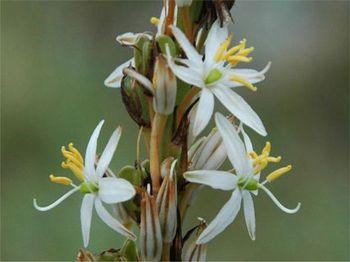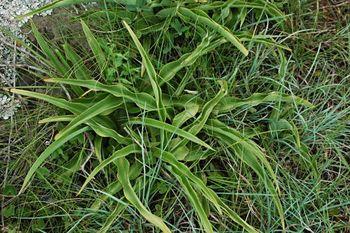Chlorophytum bowkeri
Chlorophytum bowkeri Baker
Family: Agavaceae
Common names: giant chlorophytum, Bowker's chlorophytum (Eng.); groot boskuikens (Afr.)
Introduction
A robust perennial herb that makes an impeccable landscape plant, when planted in a mass as a ground cover.

Description
Description
Chlorophytum bowkeri is a hardy, evergreen, rhizomatous, perennial groundcover, that grows up to 1 m tall. The roots are fibrous, fleshy and cylindrical. It forms large, dense clumps of many, strappy, bright green leaves. The long, narrow, channelled, fibrous-textured leaves are carried on a long, fleshy peduncle, from the base of the plant, forming a rosette. Leaf size is approximately 300 mm long and 20–60 mm wide.

Flowers are clustered in long spikes at the top of thin stems, with more than one flower per bract. The pure white, star-shaped flowers, 20 mm in diameter, are quite showy, with their prominent, long, yellow anthers; they are short-lived and close at night time. It flowers in summer (November to February). Fruits are small, 10 mm in diameter, ovoid capsules, which ripen in autumn (late April to June).

Conservation Status
Status
Chlorophytum bowkeri is common and widespread and is, thus, listed in the Least Concern (LC) category in the Red List of South African plants.
Distribution and habitat
Distribution description
Chlorophytum bowkeri is not endemic to South Africa; it also occurs in Mozambique, Swaziland and Zimbabwe. In South Africa it is widely spread in the Eastern Cape, Gauteng, KwaZulu-Natal, North West, Mpumalanga and Limpopo Provinces. It occurs naturally in the summer rainfall region, Highveld, subtropical east coast and bushveld savanna. It can be found from an altitude of 1 200 to 2 000 m, where it grows in montane grassland and forest margins, often forming colonies in damp grassland.
Derivation of name and historical aspects
History
The name Chlorophytum is derived from the Greek chloros, meaning ‘yellow green’ and phyton, meaning ‘plant’, referring to the green leaves. The species was named after a South African naturalist, J.H. Bowker (1822–1900), who sent a living plant to the Royal Botanic Gardens at Kew, in England.
The genus has about 200 species of evergreen perennial plants spread in tropical and subtropical Africa, Asia and Australia.
Ecology
Ecology
Giant chlorophytum is a water-wise and frost-hardy species. It prefers loam soil that is slightly acidic.
Its pure white, unscented flowers attract butterflies, bees and other small insects. It is commonly found growing in moist, partial shade, woodlands, forests and rocky habitats. If it gets damaged by frost, it will send out new leaves in spring.

Uses
Use
Gaint chlorophytum is a beautiful plant that can be used to great effect in a large landscape. Horticulturally it can be used as an attractive edging for flowerbeds and pathways, and planted in groups to give a natural ‘wild’ look, in shady areas and in forest gardens. It can also be used in a formal garden, like a courtyard, and is suitable for containers. It is an easy grower and requires very little maintenance. Medicinally chorophytums are used in traditional medicine and as protective charms.
Growing Chlorophytum bowkeri
Grow
Chlorophytum bowkeri can be propagated by rooting plantlets (offshoots that grow out from the main plant), division, and can be grown from seed.
Seeds should be sown in spring or summer, in a warm shady area. Seed should be sown in deep, 5 cm trays, in a mixture of equal parts river sand and fine compost, and kept semi-shaded and moist. Germination takes 3–6 weeks. Seedlings should be potted up into individual containers during their second year and can be planted into the garden or permanent pots in their third year. It prefers a well-drained and slightly acidic soil, with lots of compost. It can be fertilised with organic fertiliser.
Clumps should be lifted and divided just after the end of their flowering period in early March (late summer–autumn). Divide large clumps using garden forks to uproot the plant and hand fork back to back, in the centre of the clump. Reduce the length of the foliage by one half and reduce the roots by two-thirds. Replant immediately and water thoroughly.
References
- Manning, J. & Paterson-Jones, C. 1988. Photographic guide to the wildflowers of South Africa. Briza, Pretoria.
- Plant care today, spider plant care: Growing the Chlorophytum comosum . Accessed: 06 July 2019. https://plantcaretoday.com/spider-plant-care.html
- Pooley, E. 1998. A field guide to wild flowers Kwazulu-Natal and the eastern region. Natal Flora Publications Trust, Durban.
- Van Jaarsveld, E. 2012. Chlorophytum comosum (Thunb.) Jaques. (Agavaceae). PlantZAfrica. http://pza.sanbi.org/ Chlorophytum comosum
- Van Wyk, B. & Malan, S. 1988. A field guide to the wild flowers of the Witwatersrand and Pretoria region. Struik, Cape Town.
- Hutchings, A., Scott, A.H., Lewis, G. & Cunningham, A.B. 1996. Zulu medicinal plants: an inventory. University of Natal Press, Pietermaritzburg.
- Grow wild purposefully indigenous. Accessed: 02 July 2019: http://growwild.co.za/trees/chlorophytum-bowkeri
- The plant library, Chloropytum bowkeri. Accessed 02 July 2019. https://www.theplantlibrary.co.za/Plants/Chlorophytum-bowkeri
- Wildflower nursery. Accessed: 02 July 2019. https://wildflowernursery.co.za/indigenous-plant-database/chlorophytum-bowkeri/
- Flora of Zimbabwe. Accessed:06 July 2019. https://www.zimbabweflora.co.zw/speciesdata/species.php?species_id=113290
Credits
Refilwe Maria Malatji
Pretoria National Botaniical Garden
September 2019
Acknowledgements: the author thanks her co-authors: Juliet Debeila, Keitumetse Lenong and Sharlotte Chuene Kwenaite; and gives special thanks to Mary Sue Ittner for allowing us to use her images .
Plant Attributes:
Plant Type: Bulb, Ground Cover
SA Distribution: Eastern Cape, Gauteng, KwaZulu-Natal, Limpopo, Mpumalanga, North West
Soil type: Sandy, Loam
Flowering season: Early Summer
PH:
Flower colour: White, Yellow
Aspect: Shade, Morning Sun (Semi Shade), Afternoon Sun (Semi Shade)
Gardening skill: Easy
Special Features:
Horticultural zones










Rate this article
Article well written and informative
Rate this plant
Is this an interesting plant?
Login to add your Comment
Back to topNot registered yet? Click here to register.